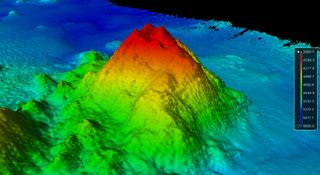Massive Extinct Volcano Discovered Beneath Pacific Ocean

Lurking some 3.2 miles (5.1 kilometers) beneath the Pacific Ocean, a massive mountain rises up from the seafloor, say scientists who discovered the seamount using sonar technology.
The seamount is about two-thirds of a mile high (1.1 kilometers), researchers said. Seamounts, rocky leftovers from extinct, underwater volcanoes, are found on ocean floors around the world. The newly discovered seamount is about 186 miles (300 km) southeast of Jarvis Island, an uninhabited island in a relatively unexplored part of the South Pacific Ocean, experts said.
"These seamounts are very common, but we don't know about them, because most of the places that we go out and map have never been mapped before," James Gardner, a University of New Hampshire research professor who works at the university's NOAA Center for Coastal and Ocean Mapping/Joint Hydrographic Center, said in a statement. [See Images of the Newfound Pacific Ocean Seamount]
Gardner's team found the seamount on Aug. 13, less than five days into an expedition to map the outer limits of the U.S. continental shelf. They used a 12-kHzmultibeam echo sounder, which uses sonar to detect contours on the ocean floor. Late that night, the seamount appeared "out of the blue," Gardner said in the statement.
The multibeam echo sounder gave the researchers an advantage over other mapping methods. Low-resolution satellite data have revealed images for most of the earth's seafloor, but the technique is not advanced enough to capture most seamounts.
"Satellites just can't see these features and we can," Gardner said.
The researchers have yet to explore the effects of the as-yet-unnamed seamount on the surrounding environment, but these underwater mountains often host diverse marine life, such as commercially important fish species, research finds. However, the newly found seamount is too deep underwater to provide a home for rich fisheries, he said.
Sign up for the Live Science daily newsletter now
Get the world’s most fascinating discoveries delivered straight to your inbox.
Still, because the seamount is so far underwater it won't be a navigational hazard. The United States has jurisdiction over the volcanic seamount and the waters above it, Gardner added.
"It's probably 100 million years old," Gardner said, "and it might have something in it we may be interested in 100 years from now."
The group made its discovery aboard the R/V Kilo Moana, a 186-foot (57 meter) vessel owned by the U.S. Navy and operated by the University of Hawaii Marine Center.
Follow Laura Geggel on Twitter @LauraGeggel and Google+. Follow Live Science @livescience, Facebook & Google+. Original article on Live Science.

Laura is the archaeology and Life's Little Mysteries editor at Live Science. She also reports on general science, including paleontology. Her work has appeared in The New York Times, Scholastic, Popular Science and Spectrum, a site on autism research. She has won multiple awards from the Society of Professional Journalists and the Washington Newspaper Publishers Association for her reporting at a weekly newspaper near Seattle. Laura holds a bachelor's degree in English literature and psychology from Washington University in St. Louis and a master's degree in science writing from NYU.
Most Popular


